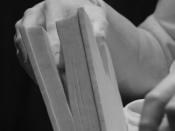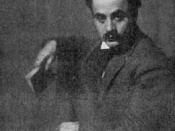"And I have found both freedom and safety in my madness; the freedom of loneliness and the safety from being understood, for those who understand us enslave something in us." -Gibran Khalil Gibran "The Madman". Shed your masks, show your faces, and you will be isolated. As the madman rushes into the market place the village folk laugh or shy away in fear; and in a damning, liberating stroke a youth proclaims "He is a madman." Exclusion and inclusion become safe-havens, prisons, executioners and crutches; and we clearly hear their echo in the lives of Bartelby, the Minister, Lenny, and the Sculptor. Rules guide those who exclude and include, and these rules are consistent; the ins are always the same, and the outs always have something special or different; and more importantly, from these stories of exclusion and inclusion, American society itself can be studied and analyzed.
The rules that determine who is in and who is out are ingrained in us.
If it can be said that Man has instincts, one of the most base and primal is the ability to discern who does not belong. Often someone among a group gives voice to the thoughts and fears of the general populace, but this is almost inconsequential, as it is already common knowledge before it is spoken. Even those who are considered "out" often know when they do not belong, as is evident in the case of Harvey Merrick and the men of Sand City. "'Harve never was much account for anything practical, and he shore was never fond of work,' began the coal-and-lumber dealer." (Cather) That one boy who could not tend the cattle and "was not fond of work," Harvey Merrick knew from the beginning that he was different. In Bartelby's world, it is obvious to...


